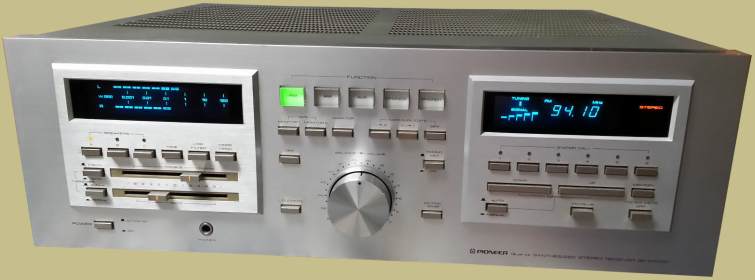
In 1980 Pioneer introduced the Pioneer SX-D7000 and made a statement that it was heading into the digital future. It’s similar in many ways to the SX-3900 except that Pioneer did away with nearly all of the knobs – replacing them with push buttons. There are no analog meter or dials either as Pioneer utilized their Fluroscan technology for the power meter and digital tuning display. The SX-D7000 retailed for about $800.

Aesthetically it’s a beautiful receiver. It has a modern, clean look to it and the symmetrical layout of the controls give it balance to the eye. It’s rated at 120 watts per channel and 0.005% total harmonic distortion.
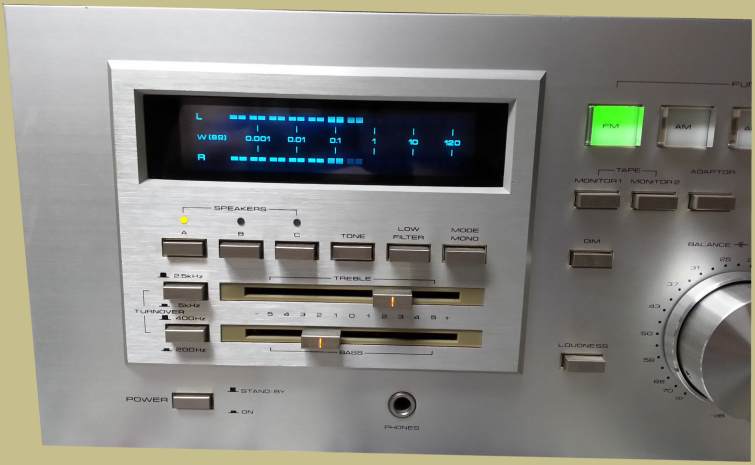
The power output and tuning meters are Fluroscan and the Treble and Bass controls are adjusted via sliders with 11 click stops. The Adaptor switch allows the user to patch in a signal processor such as a graphic equalizer or reverb unit.
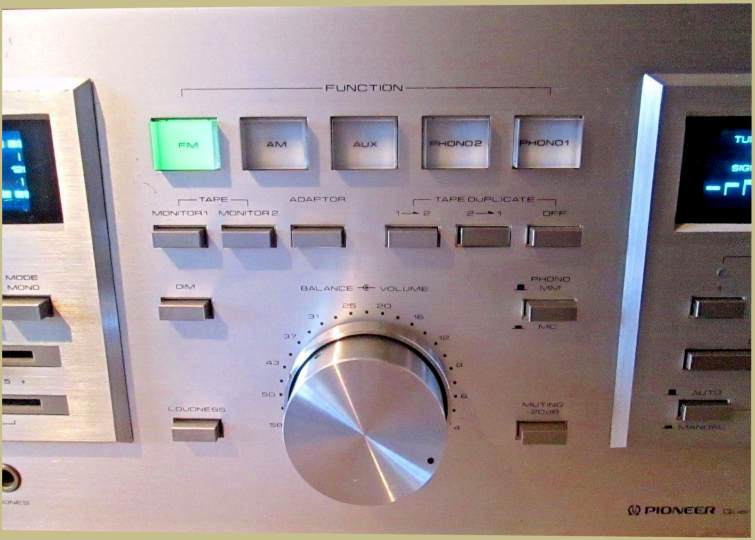
The SX-D7000 was the bigger brother to the Pioneer SX-D5000 and was slightly bigger and a little heavier. Pioneer also added a C speaker switch, Tone on/off control, a display dimmer and a second phono input. The SX-D7000 was one of the first receivers to incorporate a preamp section that could handle both a moving magnet and a moving coil cartridge. The user could switch between cartridges with the push of a button just to the right of the volume knob. Switching to the MC position boosts the phono gain by 20dB and reduces the impedance to 100 ohms.
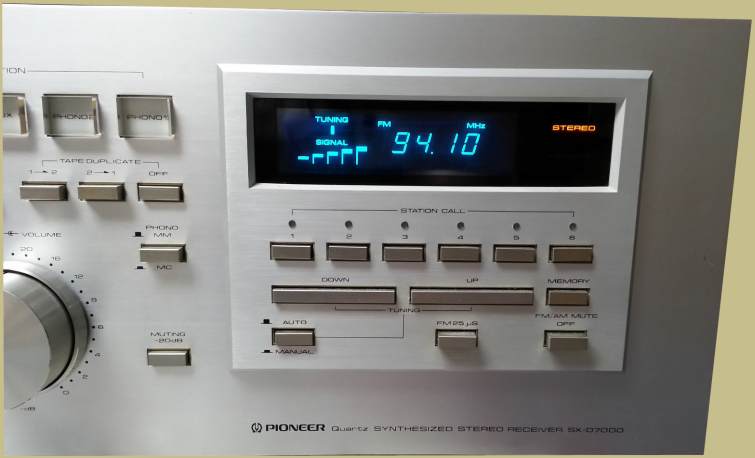
The SX-D7000 also features:
- Non-switching DC power amp design
- Quartz PLL Synthesizer Tuner
- 6 FM and 6 AM station memory for easy tuning
- High Gain FET phono equalizer
- Attenuator type master volume control
To set the memory for a station you tune to the station using either the autoscan or manual scan and then push the memory along with one of the station call buttons.
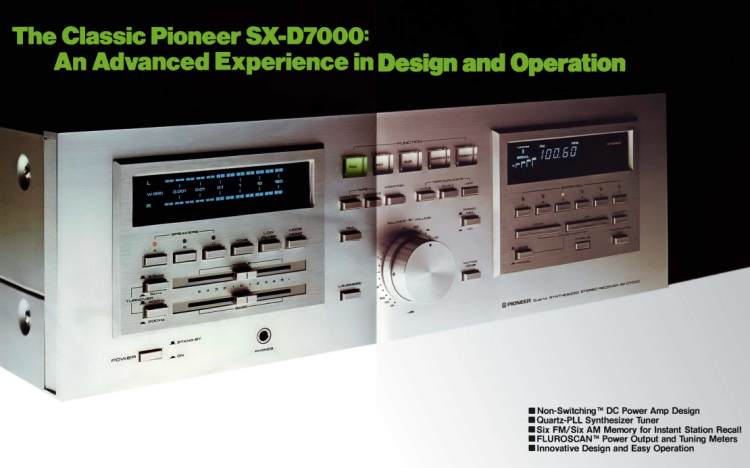
The power amp is a Direct Current configuration. Coupling capacitors are used at the input of the amp to safeguard the circuits and speaker systems. Ultra-low-frequency signals which might be picked up from a warped record can cause annoying Doppler distortion in drivers, adversely modulating the audible frequencies. Pioneer’s DC configuration removes signal-delaying capacitors from the negative feedback loops to reduce phase distortion. This contributes to a “sharp and densely-textured sonic imagery in the final reproduction“.

Pioneer avoided the problems associated with Class A or Class B amps by designing a special circuit they called Vari-Bias. According to them it is:
“An inspired breakthrough that led to the Pioneer Vari-Bias circuit, which constantly monitors the amplitude of incoming signal, then automatically controls the amount of bias fed to the power transistors. While they ‘rest’ during no-signal periods they get only a trickle – just enough to keep them from switching off. Actually, this circuit is so simple it does not limit the transient response of the transistors in any way.”
The Pioneer SX-D7000 has three power transformers. One is toroidal, for the non-switching power amp, and the other two are of conventional design.
It has three speaker outputs as well as two Phono inputs and one Aux input. It even has an AM Stereo out.
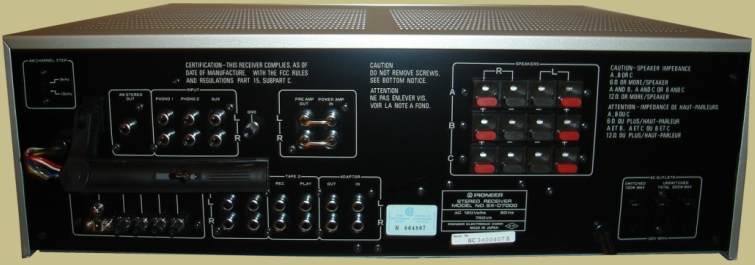
The SX-D7000 is the beginning of the end for silver faced receivers. It wasn’t long after its introduction that audio manufacturers, including Pioneer, moved toward cheaper black plastic components. The receiver has a distinct look to it that some like and some don’t. It’s still very popular for its performance level can usually be bought for a reasonable price.
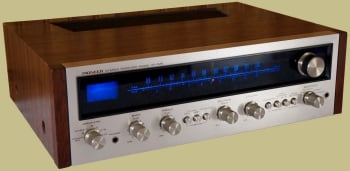
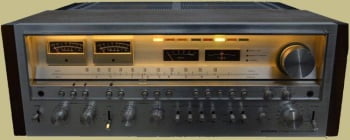
Let others have their SX-1250 or SX-1980–I want one of these (with the wood sideburns of course). The amp could probably hold its own against the A-26…pity its tuner, effectively that of the TX-D1000, wasn’t quite up to the same standard as that of Pioneer’s analog receivers of the day (let alone those of their legendary TX-9500II or F-26 tuners). Still, its rarity and unique Series 20-like styling make this a must-have for Pioneer fans.
Had one loved it
Hi Mark. enjoyed reading you comment reference the Pioneer SXD7000 flourscan receiver. Will agree with you on this point reference the pioneer analog tuners. The matching SA 9500 or SA9500 II along with the TX9500II would be one of the best combo to have in vintage audio. would love to have the Pioneer slim line F26 tuner but that boy is extremely rare along with the F28 tuner. The TX9500II tuner would be all anyone would need today considering the lousy broadcast capability of most FM station equipment being currently in use.
I need the power output circut for an Receiver Pioneer SX-D7000 if you can help me to obtain this parts for my stereo I will appreciate so much to you if is posible new or used. Thanks
I just bought one my first monster receiver….hooked up to Bose 901 series3. OMG OMG bad ass I’m keeping it.Friends and Family think I’m restoring it to sell it….Silly people
It doesn’t actually have AM Stereo out. It has MPX out for an AM Stereo adaptor unit. WIthout the unit, you won’t be able to receive proper AM stereo transmissions.
I have a Pioneer sx-D7000 that all the sudden stopped playing music not am fm phonograph or cd don’t want to let go of this unit that I’ve had for over 30 years can someone please 🙏help
Check audiokarma.org. Do a thorough search there–or post a question there and ask them what to do. That site has an amazing wealth of knowledge, and *someone* there will be able to help you figure out what is wrong and how (or who) to fix it. Be aware, it may involve the use of a soldering gun, most people there seem quite comfortable with working on their gear themselves.
I bought one of these when I was in the Military in England when they came out. It took almost all of my monthly salary back then but it was the best thing I ever saw. I still have it and finally took it out of storage and plugged it in. OMG! I forgot how good it sounded with a good set of speakers. I lost the CS-922A’s I used to run with it but the processor and other parts are still with me. It needs a little TLC now with some of the lights not working and a scratchy volume control system but in time I might fix it. If you have one, never let it out of your sight because they do not make stuff like this anymore. Unless you’re a Sound Design kind of person. Getting a little old for loud music anymore but it sure was fun to finally power t up again.
I currently own my second SX-D7000. The first one I bought new in Japan. A number of years ago it was stolen. I also bought a pair of Pioneer CS-803 speakers at the time that I still own. Hooked up to the SX-D7000 are, besides the 803s, a pair of Pioneer 703s and 903s. Plus a Pioneer PD-555RW read/write CD with remote, a Pioneer GR-777 20 band EQ (10 left/10 right) with dual spectrum analyzers (no remote), a Pioneer PD-Z85M six/single CD player with a proper six disc remote and a 3.5mm mono phono cord connected between the EQ (master unit) and the CD (slave unit) to make the remote work. I also have a Pioneer PL-4 direct drive turntable on the way and a reverse RIAA adapter that will allow the HDTV to be connected to the Phono 2 input. The AUX is connected to an LG Blue Ray disc player. (I ran out of inputs. So I’m connecting the HDTV to Phono2.) Please, let me know what you think of my Pioneer stereo system.